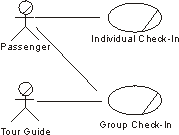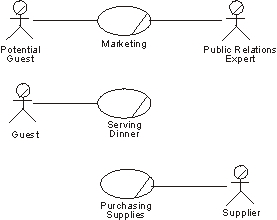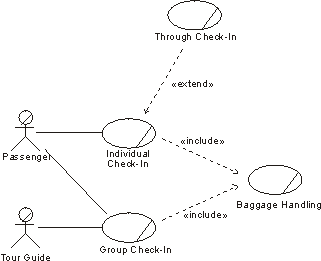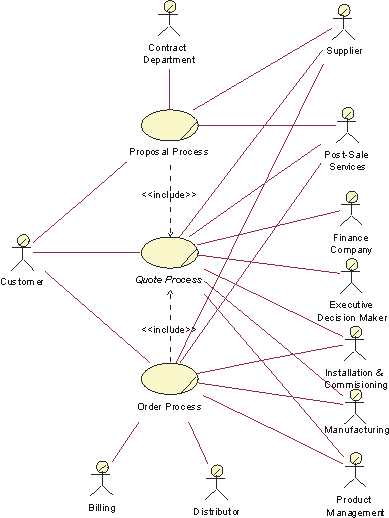SWEN 5135 Configuration Management

Business Use-Case Model |
A
business use-case model is a model that describes the
processes of a business and their interactions with external parties like
customers and partners. |
Topics
A primary purpose of the model of business use cases and actors is to
describe how the business is used by its customers and partners. Activities that
directly concern the customer, or partner, as well as supporting or managerial
tasks that indirectly concern the external party can be presented.
The model describes the business in terms of business use cases, which
correspond to what are generally called "processes".

Actors and use cases at the check-in counter.
When looking at the activities in a business you will be able to identify at
least three categories of work corresponding to three categories of business use
cases:
- First, there are the commercially important activities, often called
business processes.
- Second, there are a lot of activities that are not that commercially
important, but have to be performed anyhow to make the business work.
Systems administration, cleaning and security are typical examples. The
business use cases are of a supporting character.
- Third, there is management work. Business use cases of management
character shows the type of work that affects how the other business use
cases are managed and the business’ relationships to its owners.
Typically, a management type of business use case describes in general the
relationships between the CEO, and people who work in the business use cases. It
also describes how business use cases are developed and "started"
(instantiated).

At a restaurant, the core business use cases are
marketing and serving dinner, and the supporting business use case is purchasing
supplies.
Note that what you regard as a core business use case can sometimes be a
supporting business use case in another business. For example, software
development is a core business use case in a software development company, while
it would be classified as a supporting business use case in a bank or an
insurance company.
A business has many business use cases. Instances of several different
business use cases, as well as several instances of a single business use case,
will normally execute in parallel. There may be an almost unlimited number of
paths a use-case instance can follow. These different paths represent the
choices open to the use-case instance in the workflow description. Depending on
specific events or facts, a use-case instance can proceed along one of several
possible paths; for example:
- Input from an actor.
- A business rule.
In modeling business use cases, you can assume that use-case instances can be
active concurrently without conflicting. At this stage of business development,
you should focus on what the business should do. Solve
potential resource conflicts during work modeling, at which stage you try to
understand how things should work in the business. Or you can
solve these problems during the implementation of the new organization by
increasing the number of employees who can perform the critical task.
Every core business use case should have a communicates-relationship to or
from a business actor. This rule enforces the goal that businesses be built
around the services their users request. If your business use-case model has
business use cases that no one requests, this should warn you that something is
wrong with the model.
Business use cases can be triggered periodically or they can run for a very
long time; a surveillance function is an example of the latter. Even these
business use cases have business actors that originally initiated them, and
expect different services from them. Otherwise they would not be part of the
business. Other business use cases will produce results for a business actor,
although they are not explicitly initiated by the business actor. For example,
the development of a widely distributed product is seldom initiated by an
identifiable customer. Instead, the need for a new product is realized from
market studies and the accumulated requests of many users.
Management and supporting business use cases do not necessarily need to
connect to a business actor, although they normally have some kind of external
contact. A management business use case, for instance, might have the owners of
the business, or the board, as its business actor.
Abstract business use cases do not need a business actor, because they are
never instantiated ("started") on their own.
There are three main reasons for structuring the business use-case model:
- To make the business use cases easier to understand.
- To reuse parts of workflows that are shared among many business use cases.
- To make the business use-case model easier to maintain.
To structure the business use cases, we have three kinds of relationships.
You will use these relationships to factor out pieces of business use cases that
can be reused in other business use cases, or that are specializations or
options to the business use case. The business use case that represents the
modification we call the addition use case. The business use
case that is modified we call the base use case.
- If there is a part of a base use case that represents a function of which
the business use case only depends on the result, not the method used to
produce the result, you can factor that part out to an addition use case.
The addition is explicitly included in the base use case, using the
include-relationship. See also Guidelines:
Include-Relationship in the Business Use-Case Model.
- If there is a part of a base use case that is optional, or not necessary
to understand the primary purpose of the use case, you can factor that part
out to an addition use case in order to simplify the structure of the base
use case. The addition is implicitly included in the base use case, using
the extend-relationship. See also Guidelines:
Extend-Relationship in the Business Use-Case Model.
- If there are business use cases that have commonalities in behavior and
structure and that have similarities in purpose, their common parts can be
factored out to a base use case (parent) that is inherited by addition use
cases (children). The child use cases can insert new behavior and modify
existing behavior in the structure they inherit from the parent use case.
See also Guidelines: Use-Case-Generalization in the
Business Use-Case Model.

Actors and use cases and the check-in counter. Here we
also show the inclusion use case Baggage Handling and the extension use case
Through Check-In.
You can use actor-generalization to show how actors are specializations of
one another. See also Guidelines: Actor-Generalization in
the Business Use-Case Model.
See also the discussion on structuring system use cases in Guidelines:
Use-Case Model.
Especially when developing business models just to "prime the pump"
for a software engineering project, you need to carefully delimit the business
modeling effort. It is in this case rarely worth it to span the whole
organization, even if you only model a subset of the business processes. To be
able to stay focused and produce results that are of the expected value you
should choose to consider a part of the whole company your "business
system", and the part you choose should be the part that might directly use
the system to be built. The parts of the organization you decide to treat as
external to the model can be represented as business actors.
Example:
The Company has decided to undertake an effort to build a new
application for sales and order management. To explore the needs of the
organization, and also to align the way business is done throughout the
organization, the first step is to build a set of business models. The
departments of The Company that will not actively use the new order application
are considered external to the model, and are represented with business actors.

Business actors and business use cases in a business
use-case model of an order management organization. This organization sells
complex solutions, custom made to each customer.
Brief descriptions of the business use cases:
Order Process: This process describes how
The Company takes appropriate actions to deliver a solution to a Customer as
defined by a set of customer requirements. The process starts when there is a
business decision to proceed with an agreed solution. This may often be in the
form of The Company receiving a purchase order from a Customer. It ends when the
Customer is satisfied with the installment and commission of the solution and
payment is received. The objective is to in a profitable way satisfy customer
requirements.
Proposal Process: This is the process of
generating a proposal(s) in response to customer requirements. The process is
triggered by an inquiry from a Customer and ends when the Customer accepts (or
rejects) any of the quote(s) in the proposal. The objective is to reach
agreement on a quote that is acceptable both to the Customer and to The Company.
Quote Process: The Quote Process is an
abstract business use case that is included in both the Proposal Process and the
Order Process. The process begins when there are customer requirements that need
a quote produced for it. The objective of the Quote Process is to produce a
solution meeting the customer requirements, and to provide it along with a
price.
A survey description of the business use-case model should:
- Summarize the purpose of the organization.
- Point out delimitations of the model – things that are not included and
the reasons why.
- State which are the primary business use cases.
Example:
This business use-case model covers the part of our Company
that manages orders from our customers, since only this part is of interest to
the software engineering project that will use the results of business modeling
as an input. For this reason, we do not include the parts of the Company that
handles billing, manufacturing, product management, and product development;
they are considered external and therefore represented as business actors.
In this organization, a sale involves not just the agreement
on a solution, but also to actually build the solution. To define a price for a
solution, you need to engineer and build it to a certain level of detail. That
is what is done in the Proposal Process. Once an agreement has been made with
the customer, the solution is engineered in all details and then installed at
the customer site. This is what is described in the Order Process. Both the
Proposal Process and the Order Process include the abstract business use case
Quote Process.
- Use cases conform to the business they describe.
- All use cases are found. Taken together, use cases perform all activities
within the business.
- Every activity within the business should be included in at least one use
case.
- There should be a balance between the number of use cases and the size of
the use cases:
- Few use cases make the model easier to understand.
- Many use cases may make the model difficult to understand.
- Large use cases may be complex and difficult to understand.
- Small use cases are often easy to understand. However, make sure that
the use case describes a complete workflow that produces something of
value for a customer.
- Each use case must be unique. If the workflow is the same as or similar to
another use case, it will be difficult to keep them synchronized later.
Consider merging them into a single use case.
- The survey of the use-case model should give a good comprehensive picture
of the organization.
Copyright
© 1987 - 2001 Rational Software Corporation
|  Artifacts >
Artifacts >
 Business Modeling Artifact Set >
Business Modeling Artifact Set >
 Business Use-Case Model... >
Business Use-Case Model... >
 Business Use-Case Model >
Business Use-Case Model >
 Guidelines >
Guidelines >
 Business Use-Case Model
Business Use-Case Model
 Artifacts >
Artifacts >
 Business Modeling Artifact Set >
Business Modeling Artifact Set >
 Business Use-Case Model... >
Business Use-Case Model... >
 Business Use-Case Model >
Business Use-Case Model >
 Guidelines >
Guidelines >
 Business Use-Case Model
Business Use-Case Model